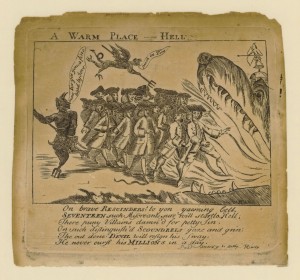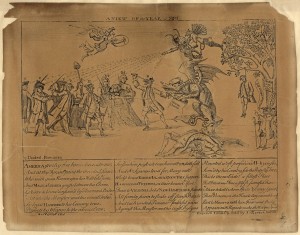
It is probably not news to readers of this blog that The New York Times recently, and favorably, reviewed the American Antiquarian Society’s Grolier Club exhibition “In Pursuit of a Vision.” But readers familiar with the two societies neither will be surprised that the AAS has exhibited at the Grolier Club in the past (in 1967 with “A Society’s Chief Joys”) and contributed items from its own collections to many exhibitions held at and sponsored by the Grolier club, including:
“Children’s Books” (1929)
“Books, Prints, and Manuscripts by and relating to Dibdin” (1935-1936)
“Engravings by Paul Revere” (1936, with an address by Clarence Brigham on March 19)
“Prints and Drawings by Hans Holbein” (1937)
“History of Navigation” (1938)
“Frankliniana” (1939)
“American Calligraphy” (1944)
“Unique Books, Pamphlets, and Broadsides” (1944)
“One Hundred Influential Books, 1640-1900” (1946)
“Caricatures Relating to America, 1760-1815” (1946-1947)
“Association Books” (1947)
“American Hand Bookbindings” (1947)
“Work of Famous American Women Writers” (1948-1949)
“Writings of Edgar Allan Poe” (1949)
“The Sea in Literature” (1953)
“Famous Children’s Books” (1953-1954)
“‘Odd Volumes’ – Books of Interest for the Unusual Nature of their Format, Binding, or Materials” (1955-1956)
“Manuscripts and First Editions of American Literature of the South” (1957)
The exhibitions, both together and separately, reveal a history of AAS collections and of America that The New York Times has called “exuberantly shapeless.” To the 1946-47 American caricatures exhibit alone, the AAS contributed three Revere engravings (“View of the Year 1765,” “Warm Place–Hell,” “View of the Obelisk”), a Nathaniel Hurd engraving (“Courtship and Marriage”), one Amos Doolittle engraving, and three William Charles works, among others. The 1947 bookbindings exhibition got an Edmund Ranger and a John Ratcliff binding from the Mather Library in addition to six other bindings. And the library provided, with other manuscripts, marbled sheets from Fanny Hill for the 1955-56 odd volumes exhibition.

Relations between the Grolier Club and AAS were friendly throughout the planning stages of each exhibition, even when disagreements arose between the two parties. For instance, after Director Clarence Brigham presented at the Revere exhibition, he was asked to publish his work with the Grolier Club. Brigham declined, writing on May 18, 1936: “I want a fairly large edition of the Paul Revere book, and I do not think that a publisher would bring out an edition if the Grolier Club in a way skimmed the cream from the market through previous publication.” The same exhibition spurred Grolier Librarian Ruth Shepard Granniss to write on March 4, 1936: “When I come to think of it, I cannot imagine how eighteen cases can be filled with Paul Revere’s work.” Brigham assured her that the cases would be filled, with 53 engravings and other works by Revere.
Out of all of the exhibitions, Brigham seemed most interested in the 1944 exhibition featuring unique books. On November 1, 1943, he even offered a volume from his personal library for the exhibition: “I have seldom seen a more attractive possibility than the projected exhibition of Unique Books and I hope that it goes through. Would ‘only known copy’ be construed as unique? The only item I have in my private library which might qualify is a Latin tract with the title ‘Oratio ad Crucifixum’ by Johannes Baptista de Cruce, Spanish printing, c. 1498, pp. 7, bound in full morocco. Every word in the text–about 1500 words–begins with the letter S and the tract was written in answer to a Jewish tract, every word of which began with the letter M. Although undated […] it was printed about 1498 and […] the only other known copy was in the Vatican. Perhaps it is not there now if the Germans have raided that library. In the library of the Antiquarian Society we have many ‘unique’ books which of course I could loan as Director.”
AAS and its staff have been dedicated to preserving the unique history of America and the printed word for a long two hundred years, through both the plundering of war and of digitization. Here’s hoping for another two hundred.
Editorial Note: Also check out our earlier post describing the current Grolier Club exhibition.
